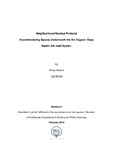| dc.contributor.advisor | Doza, Dr. Sajid-Bin- | |
| dc.contributor.advisor | Nobi, Abul Fazal Mahmudun | |
| dc.contributor.advisor | Khan, Tanjina | |
| dc.contributor.advisor | Sultana, Sheikh Rubaiya | |
| dc.contributor.advisor | Awal, Nandini | |
| dc.contributor.advisor | Urban design | |
| dc.contributor.author | Nawar, Aniqa | |
| dc.date.accessioned | 2019-05-19T08:47:55Z | |
| dc.date.available | 2019-05-19T08:47:55Z | |
| dc.date.copyright | 2018 | |
| dc.date.issued | 2018-02 | |
| dc.identifier.other | ID 12208024 | |
| dc.identifier.uri | http://hdl.handle.net/10361/12077 | |
| dc.description | This thesis is submitted in partial fulfillment of the requirements for the degree of Bachelor of Architecture, 2018. | en_US |
| dc.description | Cataloged from PDF version of thesis. | |
| dc.description | Includes bibliographical references (page 63-65). | |
| dc.description.abstract | Years of unplanned and organic growth in the city, Dhaka has given birth to countless urban voids and grey areas. With the intention to solve infrastructural problems and development, the Mega city has developed a chaotic character like any other developing country in the world. These are spaces which are often either neglected or forgotten in the eyes of people, eventually causing rapture in the urban fabric. The hypothetical inquiry arises on how we can transform these urban grey areas into positive spaces by socio-cultural and economic development for the communities and impact the sustenance and pattern of the city as a whole.
Anti space, border zones and urban grey areas are typically confusing as they are the by-products or left-overs of different employments. In many case, these can be utilized to knit together the fabric of the city. These interstitial spaces can go about as potential spaces for urban rebuilding. They can be seen as opportunities for open spaces which today involve pivotal segments of the city, both as far as the physical and also socio-cultural capacity that they may serve.
Beneath the Tejgaon-Bijoy Sarani link road flyover there is an urban void that cuts through the Tejkunipara and Nakalpara organic neighborhood like a slice of cake. The intention is to design a space that performs to stitch the once very communal neighborhood and create a destination cultural hub for the urban dwellers en bloc. | en_US |
| dc.description.statementofresponsibility | Aniqa Nawar | |
| dc.format.extent | 65 pages | |
| dc.language.iso | en | en_US |
| dc.publisher | Brac University | en_US |
| dc.rights | Brac University theses are protected by copyright. They may be viewed from this source for any purpose, but reproduction or distribution in any format is prohibited without written permission. | |
| dc.subject.lcsh | Architecture--Bangladesh. | |
| dc.subject.lcsh | City planning. | |
| dc.title | Neighborhood nucleus protopia accommodating spaces underneath the Tejgaon-Bijoy sarani link road flyover | en_US |
| dc.type | Thesis | en_US |
| dc.contributor.department | Department of Architecture, Brac University | |
| dc.description.degree | B. Architecture | |

